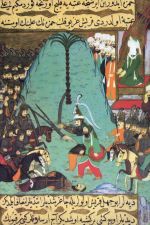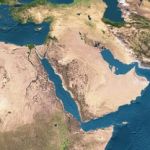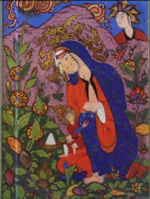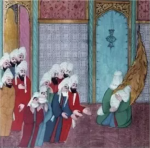Main Page
- A number of transformative steps have been undertaken as part of an ongoing effort to improve the content, professionalism, and reliability of WikiIslam..read more
- Help Wanted: Contribute Today
The first centuries of the Islamic Hijri calendar, starting in the CE year 622, were the formative years of the religion. Between the first and third Islamic centuries the Qur'an was written down and codified, the prophet lived and died, the great hadith collections were gathered, the sira of the prophet was committed to writing, the great schools of Sunni jurisprudence came to be, and the theology of Islam attained its familiar form. These years thus can be said to cover the formation of the religion of Islam as we know it today.
Islam arose in 7th century Arabia, and as such its appearance bears the markings of its ancient Arab and Near East milieu.
The Qur'an, Hadith, Scripture pages are a special category of pages here at WikiIslam. Rather than being encyclopedia articles, these pages bring together a unique collection of Quranic verses, hadith, sira traditions, tafsir, writings of classical scholars and rulings of contemporary Islamic sheikhs and ulemaa. These pages are organized by theme to assist the student, searcher or researcher.
The idea of scripture is central to Islam; above all else, Islam's own scriptures tell of how Allah has periodically given his followers books throughout the ages, and refers to Islam's co-Abrahamic religionists as People of the Book. The central scripture of Islam is above all the Qur'an, which orthodox Sunni and Shi'i Islam see as the literal word of Allah through his messenger Muhammad.
Islamic law, or the Shariah, is held to comprise the specific rulings intended by Allah for all of mankind in all times and places and delivered through Islamic scriptures (namely, the Quran and hadith). Fiqh, or Islamic jurisprudence, comprises the legal and interpretive theories through which these rulings are derived from the Quran and hadith. Norms observed and prescribed by Muhammad in these scriptures are, as a rule, taken literally and considered binding.
There is much in Islamic scripture that is not of direct legal relevance and which can be understood as constituting doctrine. The Arabic word aqeedah, or creed, has generally been understood to encompass a more limited range of ideas than what, to a modern person, would appear as Islamic doctrine.
Among the many and diverse matters discussed in or touched upon by Islamic scriptures are topics of direct or indirect scientific interest. These topics include reproductive science, embryology, cosmology, and medicine, among others.
The Qur'an and Sunnah make constant reference to stories from the Judeao-Christian tradition. The audience for the Qur’an was clearly well-acquainted with these stories and the Qur'an itself says that it is a "reminder" (73:19) of the message which came before. The stories referenced are not only from the Bible, but come from a wide variety of literary traditions from within ancient near east Christianity and Judaism.
The conflict between modern human rights doctrine and Islamic law can, for the most part, be understood as a product of their extreme historical and contextual distance. Whereas Islamic law was formulated in the harsh, unpredictable, and austere environment of 7th-9th century Arabia, modern Human rights doctrine is generally traced back to the European Enlightenment.
Muhammad, the founder of Islam, is one of the most vigorously revered men to have ever lived. His legacy has meant many different things to many different people throughout history. Information on his life comes almost exclusively through oral reports (hadiths) compiled, for the most part, more than a hundred and fifty years after his death.
The wives of the prophet are described as "أمهات المؤمنين" or "mothers of the believers." As such the prophetic example is considered instructive for all Muslim households. How the prophet interacted with his wives, and how they obeyed him, is a framework for how Muslim husbands and wives ought to interact, as well as how men should interact with their own female slaves.
Muhammad's contemporaries, companions, and successors play an elevated role in the lore of Islam. It is against many of his contemporaries that Muhammad defined his movement, it is through his companions that his tradition was passed forth, and it is by his immediate successors that his legacy was interpreted and formalized.
- Allah (God)
- Mary, Sister of Aaron
- If Anyone Slays a Person (Qur'an 5:32)
- Sources of Islamic Theories of Reproduction
- Dhul-Qarnayn and the Sun Setting in a Muddy Spring - Part One
- Dar al-Harb and Dar al-Islam (the Abodes of War and Peace)
- Isa al-Masih (Jesus Christ)
- Shaheed (Martyr)
- Sahih Bukhari
- Parallels Between the Qur'an and Late Antique Judeo-Christian Literature
|












